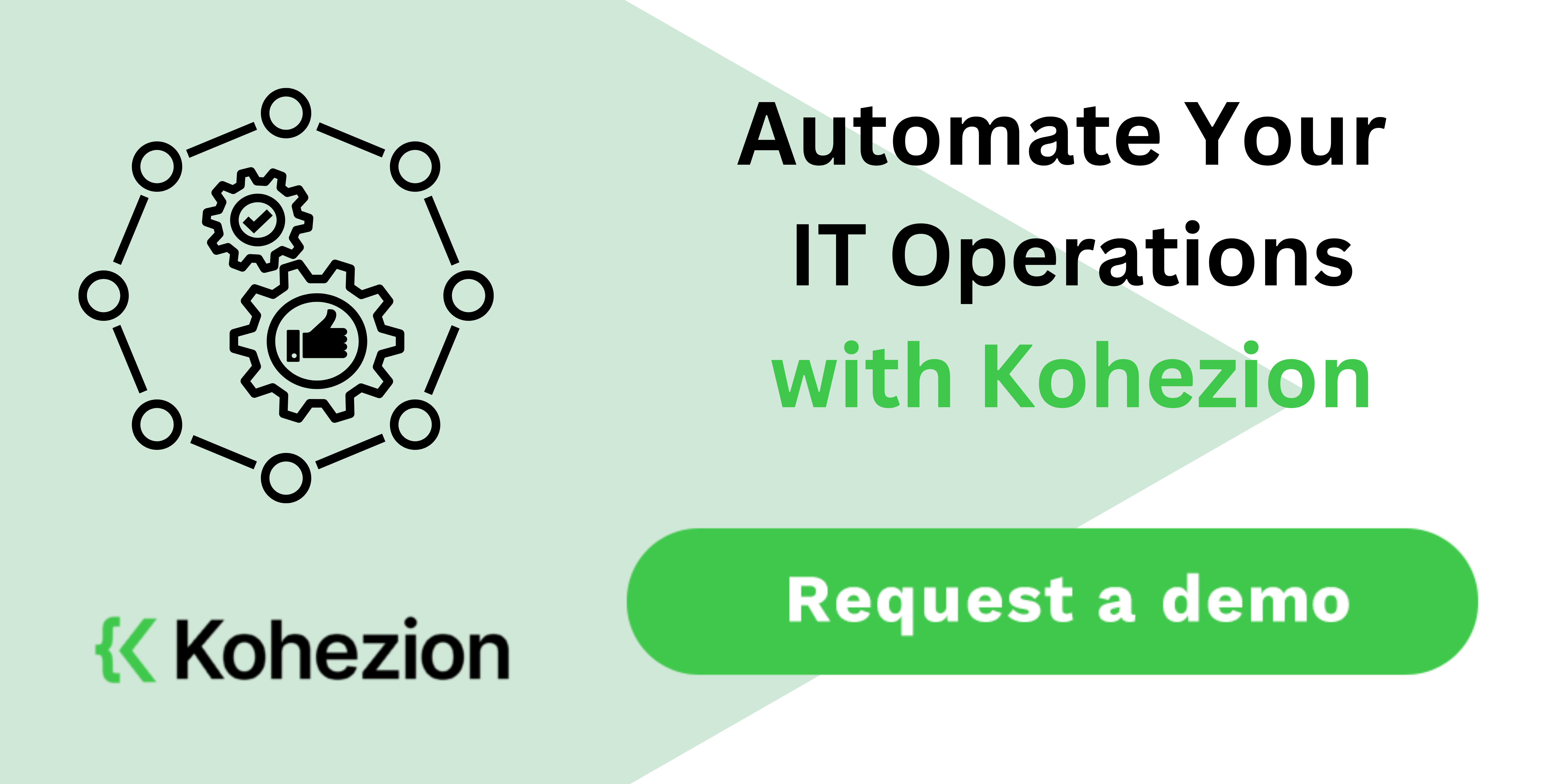IT automation tools streamline complex IT tasks and reduce the need for human intervention. But how do you choose the best IT automation tool for your business? Statistics reveal that companies lose an average of $147,000 annually due to IT downtime, highlighting the need for efficient IT automation tools.
This post lists the 14 best IT automation tools for the year ahead, offering insights to help you make informed decisions for your organization's IT infrastructure.
We'll buid your first application for you. At no extra cost.
Let us build your first business application for free. Go from an idea to an application in under 2 weeks.

What Are IT Automation Tools?
IT automation tools are software solutions that streamline and simplify various IT tasks. These tools automate repetitive processes, reducing the need for manual intervention and freeing up valuable time for IT professionals. Automation makes tasks like system updates, data backups, network configuration, and software deployment much faster and more consistent.
IT automation tools range from simple scripting utilities to comprehensive platforms equipped with advanced capabilities. They help organizations to improve efficiency, reduce errors, and allocate resources more strategically by automating routine IT operations. These tools optimize workflows, improve productivity, and support business growth and development.
Why Are IT Automation Tools Important?
The importance of IT automation tools lies in their ability to optimize IT operations, reduce costs, and improve service delivery. They enable IT teams to manage their infrastructure more effectively, ensuring that IT services are available, secure, and scalable.
Benefits of IT Automation Tools
IT automation tools offer several benefits, including:
- Increased Efficiency: Over 85% of employees believe that automation will make their job easier, and more than half of businesses implement automation to improve efficiency. Automating routine tasks speeds up operations and reduces downtime. With IT automation tools, processes that used to take hours or days can now be completed in minutes, allowing teams to accomplish more in less time. These tools optimize workflows and minimize manual interventions, improving efficiency across the organization. Automation also streamlines communication and collaboration between departments, ensuring easier coordination and faster decision-making.
- Cost Reduction: Implementing IT automation tools reduces the need for manual labor, saving on labor costs in the long run. Automation also streamlines processes, lowering operational expenses associated with inefficiencies and errors. Minimizing downtime through proactive monitoring and problem resolution also helps prevent revenue loss and reduce the costs associated with system failures.
- Enhanced Compliance: IT automation tools provide consistent processes and documentation essential for demonstrating adherence to industry regulations and internal policies. They automate compliance-related tasks such as audits, reporting, and policy enforcement, helping organizations reduce non-compliance risk and associated penalties. Automation also helps streamline the implementation of security measures, ensuring data protection and privacy following regulatory requirements.
- Time Savings: 73% of IT leaders attribute automation to enabling employees to reclaim 10-50% of the time they previously dedicated to manual tasks. Automating repetitive tasks, such as software updates, data backups, and system maintenance, reduces the time required to complete these activities manually. This frees up time for IT staff to focus on high-value tasks requiring human intervention. Over time, the time savings from IT automation can result in increased productivity, faster project delivery, and improved efficiency within the organization.
- Reduced Errors: IT automation tools help minimize errors in IT processes, leading to greater accuracy and reliability. They eliminate the potential for human error that often accompanies manual execution, resulting in improved IT operations quality. Automation also ensures consistency in task execution and helps prevent costly mistakes that can result in system downtime or data loss.
- Improved System Reliability: Proactively identifying and resolving IT issues reduces downtime and ensures uninterrupted operations, improving system reliability. Automation facilitates real-time IT infrastructure monitoring, allowing organizations to detect and address potential issues before they escalate into major problems. Automation also streamlines maintenance tasks, such as software updates and patch management, reducing the risk of vulnerabilities and system failures. This improved reliability improves the user experience and increases confidence in the organization's IT infrastructure.
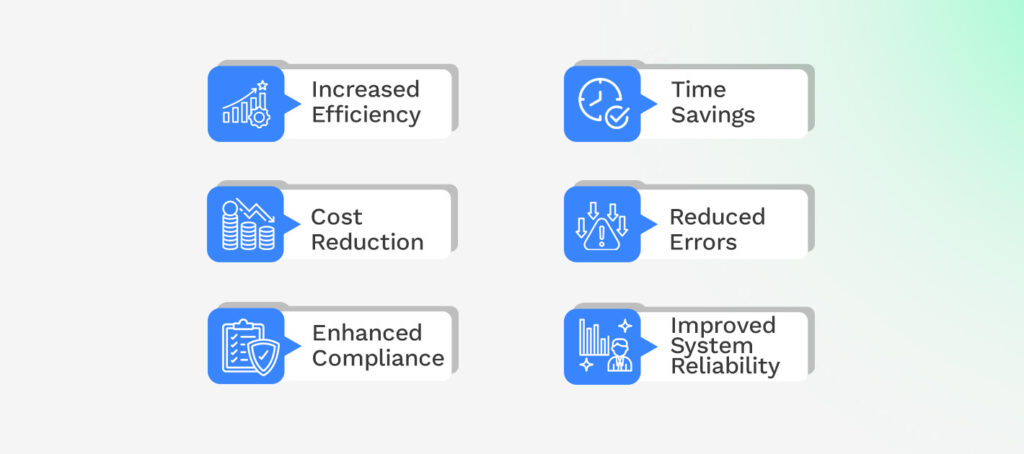
Top 14 IT Automation Tools
Let's take a look at the top 14 IT automation tools.
1.Kohezion
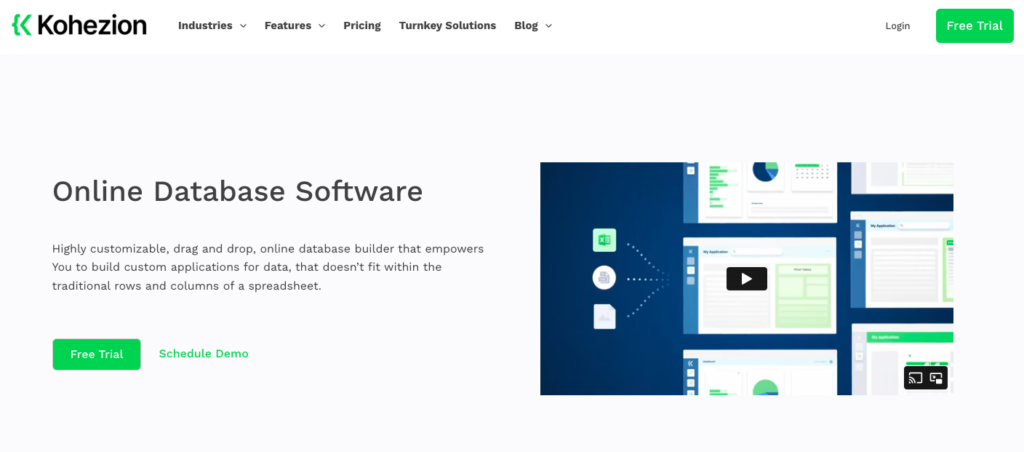
When it comes to automated IT operations, Kohezion stands out as a crucial player. It offers features designed to optimize your workflow and save you invaluable time. With Kohezion, you can automate repetitive tasks such as data entry, report generation, and task assignments, freeing your team to focus on more strategic tasks. Kohezion also provides customizable workflows and templates, allowing you to streamline processes and improve efficiency across your organization.
Top features:
- Automates repetitive tasks
- Streamlines IT operations, freeing up your team
- Integrates well into existing tech ecosystems
Pros:
- Features an intuitive interface
- Allows users to create and customize workflows tailored to their specific needs
- Automates repetitive tasks, saving valuable time and increasing efficiency
- Offers collaboration tools that facilitate teamwork and communication among team members
- Provides comprehensive support resources, including documentation, tutorials, and customer service
Cons:
- May have limited integration options with other software systems
- Mastering all features and capabilities may require some time and effort
As for pricing, it's cost-effective, but detailed rates can be obtained from their sales team.
2. ServiceNow

ServiceNow is a top choice for IT operations automation due to its end-to-end orchestration of processes and full-scale automation. With ServiceNow, teams can streamline and automate IT operations, from incident management to change management. This end-to-end automation enables users to deliver services quickly and efficiently, ensuring tasks are fulfilled on time and improving productivity. ServiceNow also provides a user-friendly interface and robust collaboration tools, facilitating communication and teamwork.
Top features:
- Automated updates integration for systems like ServiceNow, Jira
- Improved cross-team collaboration, mitigating time-consuming handoffs
- Compliance assurance with enforced policies, controls, and audit trails
Pros:
- Increases enterprise velocity and eliminates manual work
- Empowers teams to process an exceptional amount of requests with zero manual effort
- Improved incident response and auto-remediation capabilities
- Cost-effective with increased process efficiency
- Reliable governance and change management
Cons:
- Pricing might be outside the reach of small businesses
- The steep learning curve for new users
- Occasional system slow down during high traffic periods
- Customizations can be complex
- Potential integration issues with other applications
Pricing: Contact Service Now directly for accurate pricing details.
3. Ansible
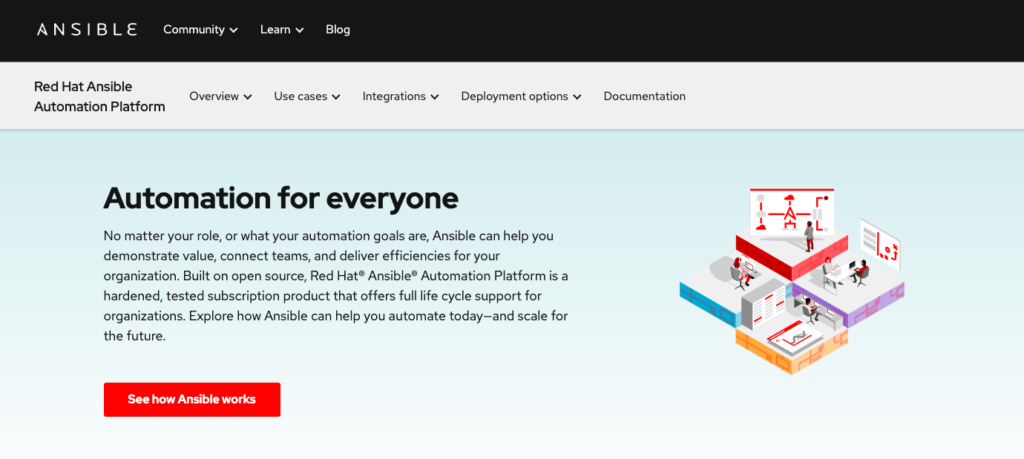
Ansible is an IT operations automation tool that simplifies complex and repetitive tasks while enhancing infrastructure management. Its straightforward YAML syntax and agentless design make it a top choice for many IT professionals. Ansible automates software provisioning, configuration management, and application deployment across an organization’s infrastructure. Its simplicity and flexibility make it accessible to beginners and experienced users, allowing for efficient automation of IT processes with minimal effort. Ansible's open-source nature and significant community support provide users with resources and expertise to draw upon.
Top features:
- Configuration management for streamlined deployments
- Ad-hoc task execution for quick action on remote servers
- Application deployment to control processes and services
- Continuous Integration and Continuous Deployment (CI/CD) for automated testing and deployment of code
- Orchestration and coordination of complex multi-tier workflows
Pros:
- Easy to use with a simple setup
- Supports a wide variety of systems
- Highly scalable for large infrastructure
- Good for multi-tier deployments
- Active community and many resources available
Cons:
- Slow runtime for some tasks
- Lacks native GUI
- Dependency on Python
- Not always the best tool for configuration management
- Can have issues with complex dependencies
Pricing for Ansible can be tied to the Ansible Tower, which offers a free trial and tiered pricing options depending on your team's needs.
4. Autodesk IT Infrastructure Automation

Autodesk IT Infrastructure Automation stands out as a top choice for streamlining IT operations, and it is known for its exceptional ability to unclog operational pipelines and drive high efficiency. It offers automation tools designed to simplify complex IT processes and increase productivity. It automates tasks like system provisioning, configuration management, and network optimization, reducing manual effort and minimizing errors. Its user-friendly interface and intuitive workflow design make it accessible to users of all skill levels, while its robust features and scalability are perfect for large enterprises. Autodesk also provides comprehensive monitoring and reporting capabilities, allowing users to track performance metrics and identify areas for optimization.
Top features:
- Automated processes
- Software-defined management
- Advanced AI implementation
- Monitors health and performance of IT operations
Pros:
- A comprehensive suite of automation tools for streamlining IT operations
- User-friendly interface and intuitive workflow design
- Scalable solution that caters to the needs of large enterprises
- Provides comprehensive monitoring and reporting capabilities
- Helps minimize manual effort and reduce errors in IT processes
Cons:
- High initial setup and implementation costs
- The learning curve may be steep for some users
- Limited customization options compared to some other automation platforms
Pricing: Contact Autodesk for a custom pricing plan that fits your business.
5. Itoolkit
IToolkit automates many IT tasks, including system provisioning, configuration management, and software deployment, streamlining operations, and improving efficiency. IToolkit also offers robust support and documentation, ensuring users have the necessary resources to succeed.
Top features:
- Streamlined IT operations
- Easy to navigate
- Advanced automation features
- Robust scalability
- Didactic learning curve
Pros:
- Increases efficiency
- Improves productivity
- Allows easy scalability
- Accelerates the learning curve
- Drives IT operations smoothly
Cons:
- Can be overwhelming for beginners
- Might overshadow other tools
- Can be costlier than competitors
- Not suited to all businesses
- Often requires expert knowledge
Pricing varies depending on the package chosen. However, the tool remains cost-effective compared to the competition.
6. HyperAutomation
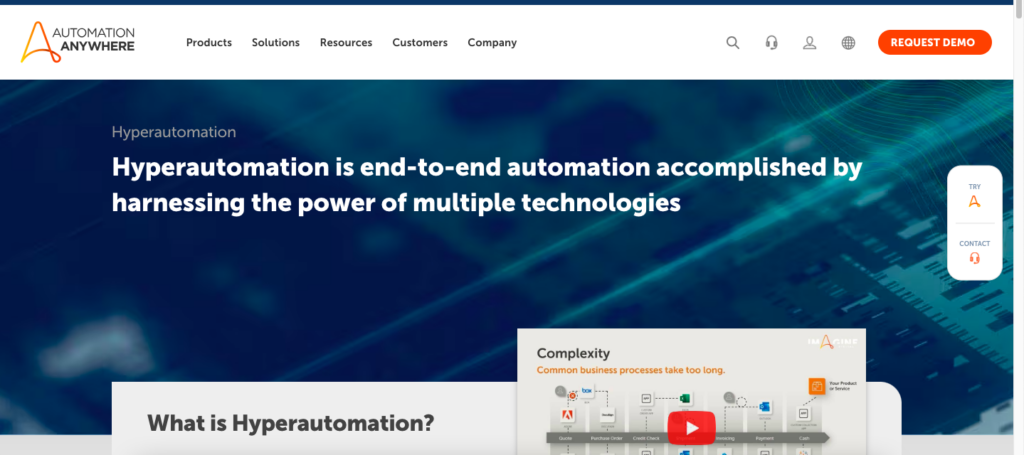
HyperAutomation is an AI and ML-powered system that streamlines your business processes, allowing you to take an effective and unified approach to automation. HyperAutomation streamlines and speeds up tasks that were once manual and time-consuming, resulting in increased efficiency and productivity. Its AI and ML capabilities enable intelligent decision-making and predictive analysis, ensuring that processes are optimized for maximum performance. HyperAutomation also offers seamless integration with existing systems and applications, making it easy to implement and adapt to your organization's unique needs.
Top features:
- Improves business and IT procedures with AI and ML
- Adapts to evolving business concepts and market expectations
- Manages cybersecurity threats efficiently
Pros:
- Accelerates business processes
- Minimizes errors, saving resources and time
- Empowers organizations to react quickly to market changes
- 35% cumulative operational cost savings from delivered automation programs
- Bridges gaps between siloed systems
Cons:
- Requires a unified approach to fill holes in the automation patchwork
- Complexity might impact easy adoption and integration
- Initial costs might be high
- Requires skilled IT professionals to manage
- Dependency on automation may risk the extinction of certain skills
HyperAutomation offers flexible pricing options tailored to the needs of businesses of all sizes.
7. CloudConfigurator
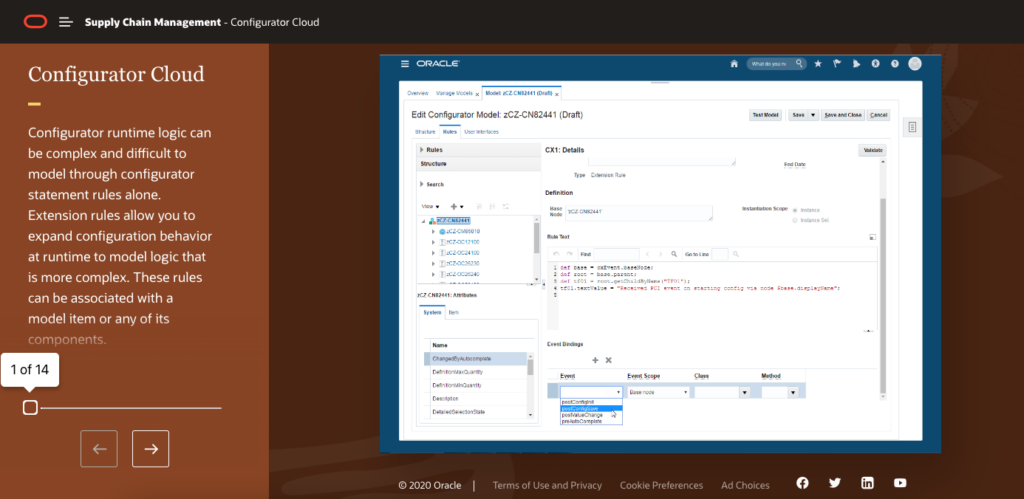
CloudConfigurator is an IT automation tool capable of managing complex multi-cloud environments. It offers features like automated provisioning, configuration management, and resource optimization, enabling organizations to streamline their cloud operations and maximize productivity. CloudConfigurator allows users to automate repetitive tasks, minimize errors, and ensure consistency across various cloud platforms, ultimately improving agility and scalability. CloudConfigurator also has robust monitoring and analytics capabilities, allowing users to gain insights into their cloud usage and performance and make informed decisions for optimization.
Top Features:
- Automates the provisioning of cloud resources
- Users can manage and optimize resources across multiple public cloud platforms
- Robust monitoring and analytics capabilities
Pros:
- Offers advanced intelligent IT automation
- Enables human input into complex resolution workflows
- Compatible with multiple public and private clouds
- Streamlines the process of deploying and managing apps
- Provides unified governance and visibility in performance
Cons:
- The setup could be challenging for non-technical staff
- It might not be affordable for small businesses
- Lack of a free version for trial
- Potential dependency on the vendor for support
- The learning curve might be steep.
The pricing of CloudConfigurator differs based on the provider's requirements and offerings.
8. JIT Automation
JIT Automation (Just-In-Time Automation) refers to the application of technology using technology to manage manufacturing processes. Its goal is to make things more efficient and reduce manual work. Implementing JIT Automation can help businesses optimize their production workflows, ensuring that the right resources are available at the right time and in the right quantities. This approach helps reduce waste, lower operating costs, and improve productivity. JIT Automation also improves flexibility and responsiveness to changing market demands, as production can be adjusted quickly and efficiently in real-time.
Top features:
- 24/7 production capacity
- Seamless adaptation to requirements
- Rapid redeployment in response to changing environments
- No painful transition periods
- Consistent delivery and quality
Pros:
- Better real-time communication
- Decreased reliance on outsourcing
- Easy system retooling
- Rapid adaptation to new procedures
- High-quality consistency
Cons:
- High upfront investment
- Requires maintenance
- Limited to repetitive tasks
- Susceptible to technical glitches
- Requires skilled workers for setup and troubleshooting
9. Nexus IT Service Management Suite
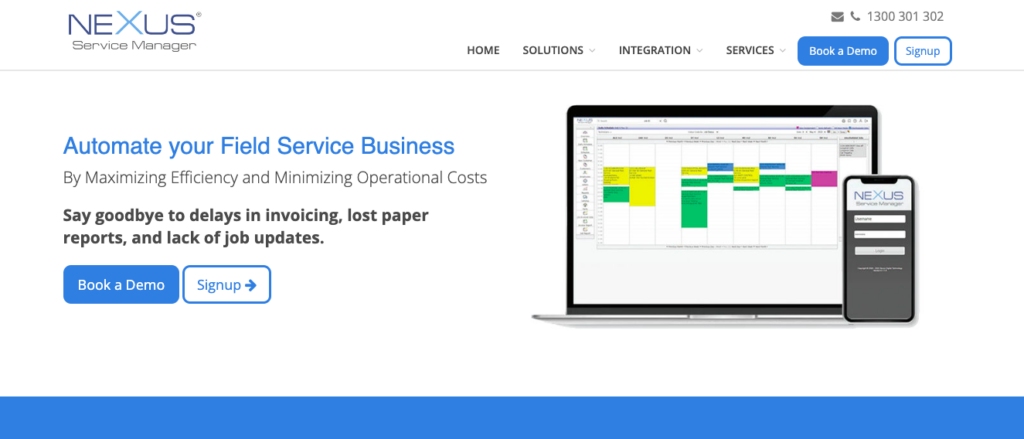
Nexus IT Service Management Suite offers seamless automation and efficient orchestration of IT operations and facilitates inter-department collaboration. The tool can help you ensure compliance with policies and controls, making it easier to manage changes and updates across your IT infrastructure. Nexus also helps improve efficiency and productivity by centralizing and automating processes, thus reducing the risk of errors and downtime.
Top features:
- Automated service requests across IT, network, and security
- End-to-end deployment with complete audit trails
- AI-driven operations for efficient infrastructure management
- Quick deployment and easy usage
- Features for comprehensive transformation engagements
Pros:
- Streamlines IT operations through seamless automation
- Facilitates inter-department collaboration for improved efficiency
- Ensures compliance with policies and controls for change management
- Provides comprehensive features for IT service management
- Offers scalability to adapt to the needs of growing organizations
Cons:
- Initial setup and implementation may require significant time and resources
- The learning curve for mastering all features and capabilities
- Cost may be high for smaller organizations
Pricing is provided upon request.
10. AutoIT
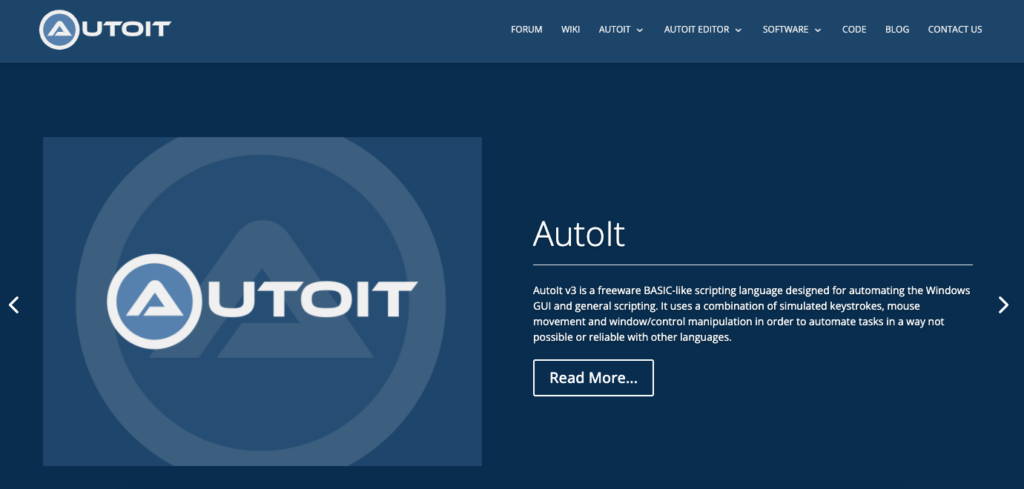
AutoIT is an excellent IT tool for automating IT operations in the Windows environment. It specializes in scripting actions, allowing users to automate repetitive tasks and streamline their IT processes. AutoIT also offers features to improve the IT experience, from automating software installations to managing system configurations. Its user-friendly interface and extensive documentation make it accessible to users of all skill levels.
Top features:
- Safe automation of application access and permissions
- Validation of alerts and elimination of false positives
- Automatic resolution of common IT incidents
- Comprehensive diagnostics capabilities
- Incremental automation and decision trees for complex events
Pros:
- Seamless data extraction
- Drag-and-drop AI for process simplification
- Unstructured data analysis
- Task/process mining
- Enables admins to run remediation steps remotely
Cons:
- Complexity in navigating the user interface
- Potential issues in certain scenarios
- The speediness of manual resolutions by SMEs could be improved
- Cumbersome for admins without direct access to systems
- Overwhelming array of IT operations automation tools to choose from
Prices vary based on usage needs, but a free trial is available to start.
11. Spiceworks IT Desktop Automation

Spiceworks IT Desktop Automation is highly regarded for its simplicity and versatility. It enables users to automate tasks easily, such as software deployment, patch management, and system monitoring. Its intuitive interface and comprehensive features make it easy even for beginners to use it. Spiceworks IT Desktop Automation also offers plenty of resources, including forums, tutorials, and user guides, to help users get the most out of the tool.
Top features:
- Comprehensive Network Monitoring
- Help Desk Automation
- Inventory Management
- Cloud Cost Monitoring
- Integration with other Spiceworks products
Pros:
- User-friendly interface makes it easy for beginners to get started
- Versatile features allow the automation of various IT tasks
- A comprehensive resource library provides support and guidance
- Free to use, making it accessible to organizations with limited budgets
- Active community forum fosters collaboration and knowledge-sharing among users
Cons:
- Limited scalability for larger organizations with complex IT environments
- Dependency on internet connectivity for certain features and updates
- Occasional delays in software updates and bug fixes due to reliance on community-driven development
The tool is free but ad-supported.
12. NoOps
NoOps, or "no operations," is a concept in IT operations automation aiming to eliminate the need for human intervention in running IT tasks. This concept is driven by technologies such as AIOps (Artificial Intelligence for IT Operations) and cloud computing services like Software as a Service (SaaS) and Infrastructure as a Service (IaaS). Leveraging these technologies can help organizations streamline their IT operations, reduce manual effort, and achieve greater efficiency and agility.
Top features:
- Use of intelligent automation tools
- AI or ML for advanced tasks
- Self-service options for business teams
Pros:
- Increased operational efficiency
- Time and resource-saving
- Faster business process iteration
- Enables business self-sufficiency
- Removes the need for constant IT monitoring
Cons:
- Assumes a cloud-native IT environment
- It doesn't address evolving data regulations
- Fails to cater to new technology needs
- May negate IT service management
- Can be challenging to maintain.
13. Prometheus
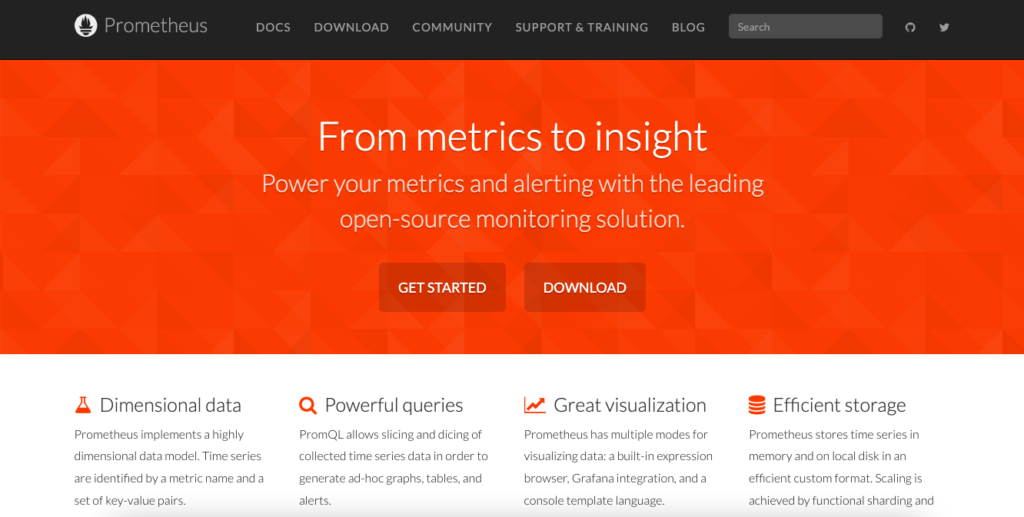
Prometheus is widely recognized for its remarkable features and capabilities for managing IT operations efficiently. The tool allows users to monitor and analyze their systems, collect metrics, and alert on abnormal behavior, ensuring optimal performance and reliability. Its flexible architecture and robust ecosystem of integrations make it adaptable to diverse environments and use cases. Prometheus also offers powerful querying and visualization capabilities, providing users with insights into their systems and enabling data-driven decisions.
Top features:
- Reliable and extensible automation
- App access and permissions automation
- Proactive checks for RAID systems, UNIX boxes, and more
- Workforce agility at scale
- Predictive insights and scalable solutions
Pros:
- Incredible capacity creation, freeing up to 10% of resources annually.
- Improves workforce agility.
- Predictive insights help you stay ahead.
- Scalable solutions grow with you.
- Automated checks ensure systems run smoothly.
Cons:
- Complexity may hinder new users
- Requires a solid understanding of IT operations
- Proactive checks can be intensive on resources
- Large-scale operations might face scalability issues
- Some users experience difficulty with the permissions automation
Prometheus offers multiple pricing packages that cater to various needs.
14. Chef Automate
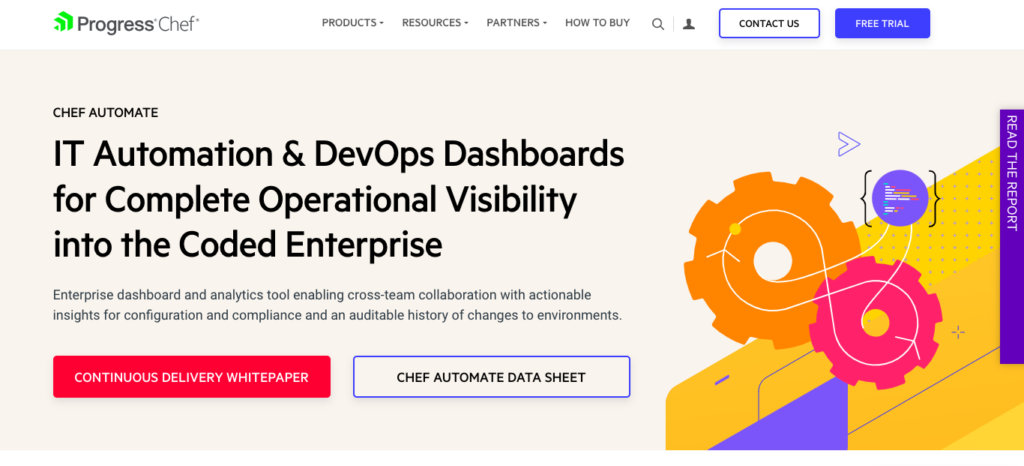
Chef Automate embraces DevOps's transparent and collaborative principles, offering a smooth transition to automation. The tool enables users to automate their IT infrastructure's configuration, deployment, and management, streamlining operations and increasing efficiency. It has an easy-to-use interface, robust features, comprehensive monitoring and reporting capabilities, and integration capabilities that allow seamless collaboration across teams.
Top features:
- It enables the management of complex networks
- Provides real-time visibility into configuration
- Incorporates compliance and security
- Integrates with popular platforms such as AWS, Azure, and Google Cloud
Pros:
- Streamlines IT operations through automation of configuration, deployment, and management tasks
- Facilitates collaboration between development and operations teams
- Offers a user-friendly interface and extensive documentation for easy adoption
- Provides comprehensive monitoring and reporting capabilities
- Integrates seamlessly with existing tools and systems
Cons:
- Has a steep learning curve for mastering advanced features and configurations
- Initial setup and implementation may require significant time and resources
- The cost of licensing and support may be high for smaller companies
Chef Automate offers a pricing model based on nodes, which befits various budget sizes and operational scales.
Features to Look for When Choosing an IT Automation Tool
When choosing an IT automation tool, consider the following features:
Scalability
The first thing to consider is how well the IT automation tool can grow with your business. Look for a tool to handle increasing workloads and adapt to evolving requirements without significant disruptions. Scalability ensures that your automation solution remains effective as your organization expands and your IT needs evolve.
Ease of Use
Choose an automation tool with an intuitive interface and straightforward implementation process. A user-friendly interface simplifies the adoption process and reduces the learning curve for your team. Easy-to-follow documentation and training resources can further improve usability, enabling users to leverage the tool's full capabilities with minimal effort.
Integration Capabilities
Ensure that the IT automation tool seamlessly integrates with your existing IT environment, including hardware, software, and other tools. Compatibility with commonly used platforms and systems allows smooth data exchange and workflow automation across your organization. Robust integration capabilities enable you to maximize the efficiency and effectiveness of your automation initiatives.
Security
Choose a tool with robust security features to protect your IT infrastructure and data. Look for encryption protocols, access controls, and compliance certifications to protect sensitive information. Consider features such as role-based access control and audit trails to increase accountability and mitigate security risks.
Support and Community
Choose an IT automation tool backed by a strong support network and an active community of users. Access to timely technical support and knowledgeable resources can help resolve issues quickly and ensure smooth implementation and operation of the tool. An active community also provides opportunities for knowledge sharing, best practices, and collaboration, enabling your team to achieve optimal results.
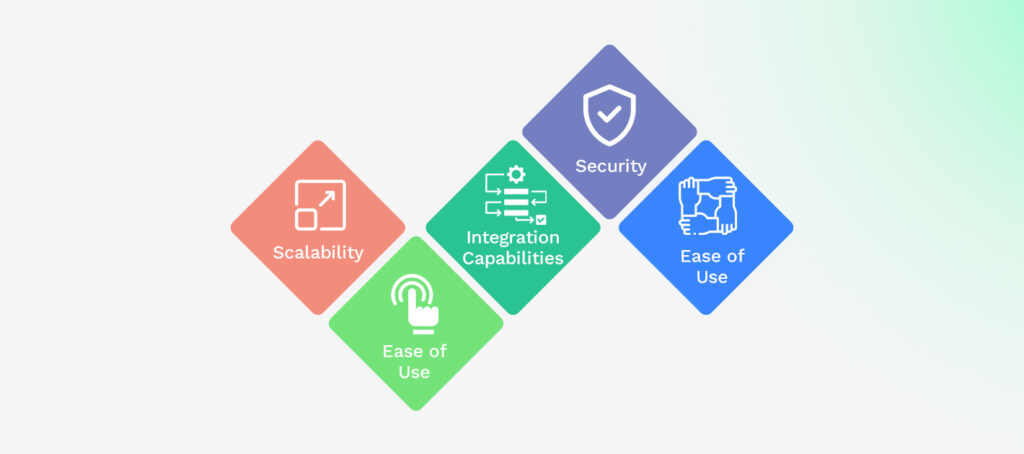
Get the Most Efficient IT Automation with Kohezion
Now that you've uncovered the potential of the best IT automation tools, it's time to turn this knowledge into action and improve your IT operations. Kohezion is here to support you on this journey. Kohezion stands out for its versatility and user-friendly approach to IT automation. It offers a robust platform for businesses seeking to automate their workflows and manage data with precision.
Contact Kohezion today to discuss how our IT automation solutions can be customized to suit your specific needs. Whether you're a small startup or a large enterprise, we have the expertise and technology to optimize your IT processes, minimize downtime, and increase efficiency.
Reach out to us now and unlock the full potential of your IT infrastructure.
Conclusion
The right IT automation tools help businesses improve efficiency, reduce manual tasks, and improve reliability in the digital age. The 14 top IT automation tools for 2024 highlighted offer diverse solutions to meet various organizational needs, from automating mundane tasks to optimizing entire IT infrastructures. Investing in IT automation is not just about keeping up with technological advancements; it's a strategic move to streamline operations, cut costs, and secure a competitive edge in front of competitors.
Frequently Asked Questions
Common challenges when implementing IT automation tools include employee resistance to change, integration issues with existing systems, the complexity of automation workflows, ensuring compliance with regulatory requirements, and choosing the right tool for the organization's needs. Overcoming these challenges requires careful planning, communication, and collaboration among stakeholders.
Success in IT automation initiatives can be measured by various metrics, including increased efficiency and productivity, reduced manual effort and errors, faster time to market, improved system reliability and uptime, cost savings, and increased user satisfaction. Establish key performance indicators (KPIs) relevant to your organization's goals and track progress regularly to assess the impact of automation efforts.
Some best practices for implementing IT automation tools include conducting thorough planning and assessment of automation needs, involving stakeholders throughout the process, starting with small, manageable automation projects, providing training and support to users, monitoring and optimizing automation workflows regularly, and continuously evaluating and adapting automation strategies to meet changing business requirements.
No, IT automation tools are not intended to replace human IT professionals entirely. While it is true that the number of automated jobs increases by 14% every year, human IT professionals bring critical thinking and problem-solving abilities that automation tools cannot replicate. Instead, automation tools complement the skills of IT professionals by handling routine tasks, allowing them to focus on more strategic tasks and complex issues. This collaboration between automation tools and human professionals enables organizations to achieve greater efficiency and innovation in their IT operations.
The cost of IT automation tools varies widely, with options available for businesses of all sizes. Many tools offer scalable pricing models to fit different budgets. While some advanced tools might seem expensive initially, the investment often pays off in terms of improved efficiency, reduced manual labor costs, and minimized errors. There are also open-source and freemium models that offer basic features for free, which can be a great starting point for smaller businesses or those looking to experiment with automation before committing to a more comprehensive solution.

